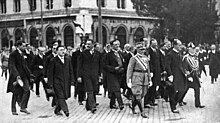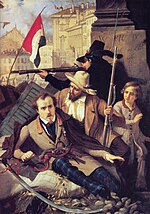
The Italian Armed Forces encompass the Italian Army, the Italian Navy and the Italian Air Force. A fourth branch of the armed forces, known as the Carabinieri, take on the role as the nation's military police and are also involved in missions and operations abroad as a combat force. Despite not being a branch of the armed forces, the Guardia di Finanza is organized along military lines. These five forces comprise a total of 340,885 men and women with the official status of active military personnel, of which 167,057 are in the Army, Navy and Air Force. The President of the Italian Republic heads the armed forces as the President of the High Council of Defence established by article 87 of the Constitution of Italy. According to article 78, the Parliament has the authority to declare a state of war and vest the powers to lead the war in the Government.

An institutional referendum was held by universal suffrage in the Kingdom of Italy on 2 June 1946, a key event of contemporary Italian history. Until 1946, Italy was a kingdom ruled by the House of Savoy, reigning since the unification of Italy in 1861 and previously rulers of the Kingdom of Sardinia. In 1922, the rise of Benito Mussolini and the creation of the Fascist regime in Italy, which eventually resulted in engaging the country in World War II alongside Nazi Germany, considerably weakened the role of the royal house.
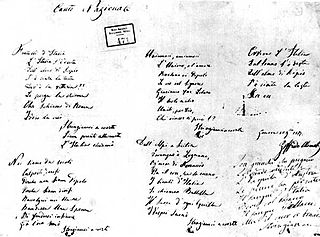
"Il Canto degli Italiani" is a patriotic song written by Goffredo Mameli and set to music by Michele Novaro in 1847, and is the current national anthem of Italy. It is best known among Italians as the "Inno di Mameli", after the author of the lyrics, or "Fratelli d'Italia", from its opening line. The piece, in 4/4 time signature and B-flat major key, has six strophes, and a refrain sung after each. The sixth group of verses, almost never performed, recalls the first strophe's text.

The national flag of Italy, often referred to in Italian as il Tricolore, is a tricolour featuring three equally sized vertical pales of green, white and red, national colours of Italy, with the green at the hoist side, as defined by article 12 of the Constitution of the Italian Republic. The Italian law regulates its use and display, protecting its defense and providing for the crime of insulting it; it also prescribes its teaching in Italian schools together with other national symbols of Italy.

Public holidays in Italy are established by the Italian parliament and, with the exception of city or community patronal days, apply nationwide. These include a mix of national, religious and local observances. As for Whit Monday, there is an exception for South Tyrol. In Italy there are also State commemoration days, which are not public holidays.
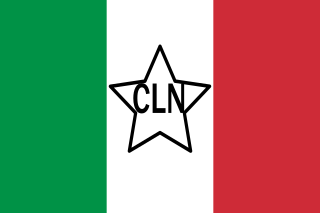
The Italian resistance movement is an umbrella term for the Italian resistance groups who fought the occupying forces of Nazi Germany and the fascist collaborationists of the Italian Social Republic during the Second World War in Italy from 1943 to 1945. As a diverse anti-fascist movement and organisation, the Resistenza opposed Nazi Germany, as well as Nazi Germany's Italian puppet state regime, the Italian Social Republic, which the Germans created following the Nazi German invasion and military occupation of Italy by the Wehrmacht and the Waffen-SS from 8 September 1943 until 25 April 1945.

The Italian Red Cross is the Italian national Red Cross society. The Italian Red Cross was one of the original founding members of the International Committee of the Red Cross in 1919.

The Victor Emmanuel II National Monument, also known as the Vittoriano or Altare della Patria, is a large national monument built between 1885 and 1935 to honour Victor Emmanuel II, the first king of a unified Italy, in Rome, Italy. It occupies a site between the Piazza Venezia and the Capitoline Hill. The monument was realized by Giuseppe Sacconi.

The emblem of the Italian Republic was formally adopted by the newly formed Italian Republic on 5 May 1948. Although often referred to as a coat of arms, it is an emblem as it was not designed to conform to traditional heraldic rules. The emblem is used extensively by the Italian government.

The Bollettino della Vittoria is the official document after the Armistice of Villa Giusti with which General Armando Diaz, the supreme commander of the Royal Italian Army, announced, on November 4, 1918, the surrender of the Austro-Hungarian Empire and the victory of the Kingdom of Italy in World War I.
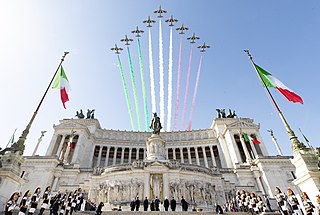
Festa della Repubblica is the Italian National Day and Republic Day, which is celebrated on 2 June each year, with the main celebration taking place in Rome. The Festa della Repubblica is one of the national symbols of Italy.

The Stella d'Italia, popularly known as Stellone d'Italia, is a five-pointed white star, which has symbolized Italy for many centuries. It is the oldest national symbol of Italy, since it dates back to Graeco-Roman mythology when Venus, associated with the West as an evening star, was adopted to identify the Italian peninsula. From an allegorical point of view, the Stella d'Italia metaphorically represents the shining destiny of Italy.
The Committee of National Liberation for Northern Italy was set up in February 1944 by partisans behind German lines in the Italian Social Republic, a German puppet state in Northern Italy. It enjoyed the loyalty of most anti-fascist groups in the region.

National symbols of Italy are the symbols that uniquely identify Italy reflecting its history and culture. They are used to represent the Nation through emblems, metaphors, personifications, allegories, which are shared by the entire Italian people.

Liberation Day, also known as the Anniversary of Italy's Liberation, Anniversary of the Resistance, or simply 25 April, is a national holiday in Italy that commemorates the victory of the Italian resistance movement against Nazi Germany and the Italian Social Republic, puppet state of the Nazis and rump state of the fascists, culmination of the liberation of Italy from German occupation and of the Italian civil war in the latter phase of World War II. That is distinct from Republic Day, which takes place on 2 June and commemorates the 1946 Italian institutional referendum.

Tricolour Day, officially National Flag Day, is the flag day of Italy. Celebrated on 7 January, it was established by Law 671 on 31 December 1996. It is intended as a celebration, though not a public holiday. The official celebration of the day is held in Reggio Emilia, the city where the Italian tricolour was first adopted as flag by an Italian sovereign state, the Cispadane Republic, on 7 January 1797.

The Tomb of the Unknown Soldier is a war memorial located in Rome under the statue of the goddess Roma at the Altare della Patria. It is a sacellum dedicated to the Italian soldiers killed and missing during war.

The Anniversary of the Unification of Italy is a national day that falls annually on 17 March and celebrates the birth of Italy as a modern nation state, which took place following the proclamation of the Kingdom of Italy on 17 March 1861.

The Bollettino della Vittoria Navale is the official document written after the armistice of Villa Giusti with which the admiral Paolo Thaon di Revel, supreme commander of the Royal Italian Navy, announced, on 12 November 1918, the surrender on the seas of the Austro-Hungarian Empire and Italy's victory in the World War I.

The Monument to the Fallen consists of sculptures, reliefs and a plaque affixed in the 1960s to the 18th-century bell-tower built attached to the now deconsecrated church of San Ludovico (previously dedicated to San Paolo and serving the adjacent Convent of that name. The bell tower is found at the intersection of Strada Macedonio Melloni, Borgo del Parmigianino, and Strada Cavour in central Parma, Italy.


